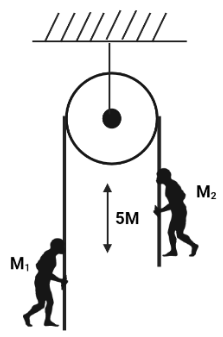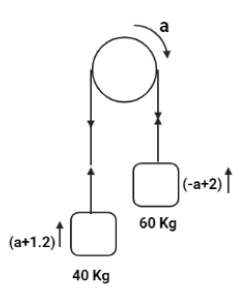
Two men of masses ${m_1}$ and ${m_2}$ hold on the opposite ends of a rope passing over a frictionless pulley. The man ${m_1}$ climbs up the pore with an acceleration of $1.2\,m{\sec ^{ - 2}}$ relative to the rope. The man ${m_2}$ climbs up the rope with an acceleration of $2\,m{\sec ^{ - 2}}$ relative to the rope. They start from rest and are initially separated by 5m. (Given ${m_1} = 40\,Kg$ and ${m_2} = 60\,Kg$).

A. Tension in the rope is $555.68\,N$
B. Tension in the rope is 556.8 N
C. Time after which they will be at the same horizontal level is 1.47 sec.
D. Time after which they will be at the same horizontal level is 2.94 sec.

Answer
508.2k+ views
Hint:We sketch the point of interest, all forces acting on it, and resolve all force vectors into x– and y–components to create a free-body diagram. Every object in the problem requires a separate free-body diagram.
Complete step by step answer:
Let us consider that the acceleration of rope is $a$ which rotates in clockwise direction. Then the acceleration of ${m_1}$ will be $(a + 1.2)$ and the acceleration of ${m_2}$ will be $( - a + 2)$. So, the final diagram is as follows:

Now, let us make a free body diagram for the two masses.

Calculating the net force we will get two equations.
For the first mass:
$T - 40g = 40(a + 1.2) \\
\Rightarrow T - 40(10) = 40(a + 1.2) \\
\Rightarrow T - 400 = 40a + 48 \\
\Rightarrow T = 40a + 448 \\ $
For the second mass:
$T - 60g = 60( - a + 2) \\
\Rightarrow T - 60(10) = 60( - a + 2) \\
\Rightarrow T - 600 = - 60a + 120 \\
\Rightarrow T = - 60a + 720 \\ $
Comapring the above two equations we get,
$40a + 448 = - 60a + 720 \\
\Rightarrow 100a = 272 \\
\Rightarrow a = 2.72m.{\sec ^{ - 2}} \\ $
Now, lets calculate the value of Tension using this value
$T = - 60a + 720 \\
\Rightarrow T = - 60(2.72) + 720 \\
\Rightarrow T = - 163.2 + 720 \\
\Rightarrow T = 556.8N \\ $
Hence, option (B) is correct as Tension in the rope is 556.8N.
Now, we will calculate the individual acceleration of each mass
${a_1} = a + 1.2 \\
\Rightarrow {a_1} = 2.72 + 1.2 \\
\Rightarrow {a_1} = 3.92\,m.{\sec ^{ - 2}} \\ $
Similarly,
${a_2} = - a + 2 \\
\Rightarrow {a_2} = - 2.72 + 2 \\
\Rightarrow {a_2} = - 0.72m.{\sec ^{ - 2}} \\ $
Now we should calculate the time when both the masses will be in the same horizontal height. Hence, we will use the following formula,
$s = ut + \dfrac{1}{2}a{t^2} \\
\Rightarrow 5 = 0(t) + \dfrac{1}{2}(2.72){t^2} \\
\Rightarrow 10 = 2.72{t^2} \\
\Rightarrow {t^2} = 3.67 \\
\therefore t = 1.48\sec $
Therefore, Option (c) is also correct as time after which they will be at the same horizontal level is 1.47 sec.
Hence, we conclude that option B and option C are the correct answer.
Note:Objects are not often subjected to four powers. The number of forces represented by a free-body diagram can be one, two, or three in some situations. The number of forces that must be drawn in a free-body diagram is not a hard and quick guideline. Drawing free-body diagrams has only one rule: represent all of the forces that occur with that entity in the specified case.
Complete step by step answer:
Let us consider that the acceleration of rope is $a$ which rotates in clockwise direction. Then the acceleration of ${m_1}$ will be $(a + 1.2)$ and the acceleration of ${m_2}$ will be $( - a + 2)$. So, the final diagram is as follows:

Now, let us make a free body diagram for the two masses.

Calculating the net force we will get two equations.
For the first mass:
$T - 40g = 40(a + 1.2) \\
\Rightarrow T - 40(10) = 40(a + 1.2) \\
\Rightarrow T - 400 = 40a + 48 \\
\Rightarrow T = 40a + 448 \\ $
For the second mass:
$T - 60g = 60( - a + 2) \\
\Rightarrow T - 60(10) = 60( - a + 2) \\
\Rightarrow T - 600 = - 60a + 120 \\
\Rightarrow T = - 60a + 720 \\ $
Comapring the above two equations we get,
$40a + 448 = - 60a + 720 \\
\Rightarrow 100a = 272 \\
\Rightarrow a = 2.72m.{\sec ^{ - 2}} \\ $
Now, lets calculate the value of Tension using this value
$T = - 60a + 720 \\
\Rightarrow T = - 60(2.72) + 720 \\
\Rightarrow T = - 163.2 + 720 \\
\Rightarrow T = 556.8N \\ $
Hence, option (B) is correct as Tension in the rope is 556.8N.
Now, we will calculate the individual acceleration of each mass
${a_1} = a + 1.2 \\
\Rightarrow {a_1} = 2.72 + 1.2 \\
\Rightarrow {a_1} = 3.92\,m.{\sec ^{ - 2}} \\ $
Similarly,
${a_2} = - a + 2 \\
\Rightarrow {a_2} = - 2.72 + 2 \\
\Rightarrow {a_2} = - 0.72m.{\sec ^{ - 2}} \\ $
Now we should calculate the time when both the masses will be in the same horizontal height. Hence, we will use the following formula,
$s = ut + \dfrac{1}{2}a{t^2} \\
\Rightarrow 5 = 0(t) + \dfrac{1}{2}(2.72){t^2} \\
\Rightarrow 10 = 2.72{t^2} \\
\Rightarrow {t^2} = 3.67 \\
\therefore t = 1.48\sec $
Therefore, Option (c) is also correct as time after which they will be at the same horizontal level is 1.47 sec.
Hence, we conclude that option B and option C are the correct answer.
Note:Objects are not often subjected to four powers. The number of forces represented by a free-body diagram can be one, two, or three in some situations. The number of forces that must be drawn in a free-body diagram is not a hard and quick guideline. Drawing free-body diagrams has only one rule: represent all of the forces that occur with that entity in the specified case.
Recently Updated Pages
Master Class 11 Economics: Engaging Questions & Answers for Success

Master Class 11 English: Engaging Questions & Answers for Success

Master Class 11 Social Science: Engaging Questions & Answers for Success

Master Class 11 Biology: Engaging Questions & Answers for Success

Class 11 Question and Answer - Your Ultimate Solutions Guide

Master Class 11 Business Studies: Engaging Questions & Answers for Success

Trending doubts
10 examples of friction in our daily life

One Metric ton is equal to kg A 10000 B 1000 C 100 class 11 physics CBSE

Difference Between Prokaryotic Cells and Eukaryotic Cells

1 Quintal is equal to a 110 kg b 10 kg c 100kg d 1000 class 11 physics CBSE

Explain zero factorial class 11 maths CBSE

What is a periderm How does periderm formation take class 11 biology CBSE




